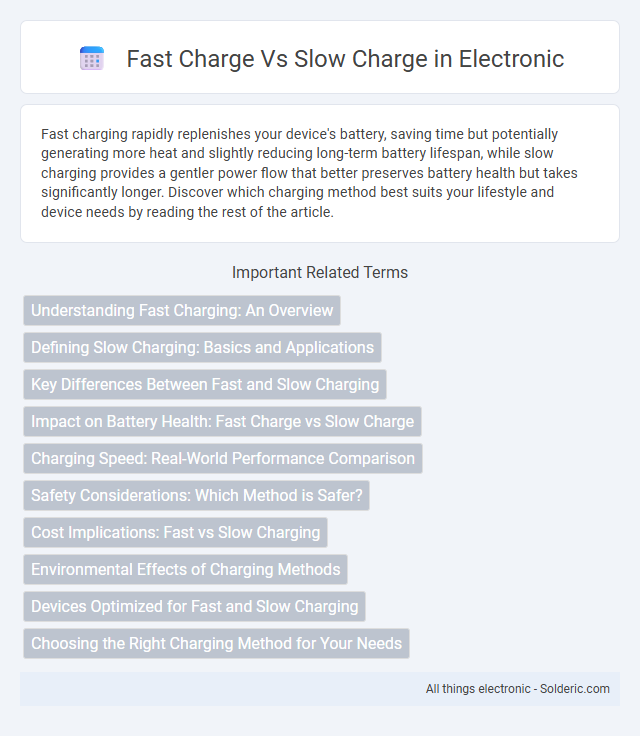Fast charging rapidly replenishes your device's battery, saving time but potentially generating more heat and slightly reducing long-term battery lifespan, while slow charging provides a gentler power flow that better preserves battery health but takes significantly longer. Discover which charging method best suits your lifestyle and device needs by reading the rest of the article.
Comparison Table
| Aspect | Fast Charge | Slow Charge |
|---|---|---|
| Charging Speed | Typically 50 kW to 350 kW, charges 80% in 20-40 mins | Typically 3.7 kW to 7.4 kW, charges full in 6-12 hours |
| Use Case | Quick top-up during travel or urgent needs | Overnight charging at home or work |
| Battery Impact | May reduce battery lifespan over time | Gentler on battery health |
| Infrastructure | Requires specialized fast chargers and higher power supply | Uses standard Level 1 or Level 2 home chargers |
| Cost | Higher installation and usage cost | Lower installation and operational cost |
| Availability | Common at highway stations and public fast charging points | Widely available for residential and workplace settings |
Understanding Fast Charging: An Overview
Fast charging technology significantly reduces the time required to recharge your device by increasing the power output delivered to the battery, typically through higher voltage or current. This method relies on smart charging protocols and advanced battery management systems to ensure safety and prevent overheating during rapid energy transfer. Understanding how fast charging works can help you make informed decisions about your device's charging habits and battery health maintenance.
Defining Slow Charging: Basics and Applications
Slow charging refers to the process of replenishing an electric vehicle's battery at a lower power level, typically using 3-7 kW chargers that take several hours to fully charge. This method is ideal for overnight charging at home or workplaces, where the extended time frame nicely fits routine schedules without stressing the battery. Your EV battery benefits from slow charging through improved longevity and reduced heat generation compared to fast charging techniques.
Key Differences Between Fast and Slow Charging
Fast charging delivers higher wattage, significantly reducing the time needed to reach full battery capacity, often providing 50-80% charge in 30 minutes. Slow charging uses lower wattage, preserving battery health by minimizing heat generation and stress on battery cells over extended periods. Compatibility with device hardware and charging infrastructure varies, making fast chargers ideal for quick top-ups and slow chargers better suited for overnight or long-duration charging.
Impact on Battery Health: Fast Charge vs Slow Charge
Fast charging generates higher heat and voltage stress, accelerating battery degradation and reducing overall lifespan compared to slow charging. Slow charging maintains a lower temperature and voltage, preserving battery capacity and promoting longer-term health. Optimal battery management systems balance charge speed with thermal control to mitigate health impacts.
Charging Speed: Real-World Performance Comparison
Fast charging delivers significantly higher power output, enabling electric vehicles (EVs) to regain 80% charge in approximately 20-40 minutes, while slow charging typically takes 6-12 hours for a full charge using AC power at lower wattage levels. Real-world performance varies based on battery capacity, state of charge, charger type, and temperature, but fast chargers employ DC power at rates often exceeding 50 kW, far surpassing the 3-7 kW range of slow chargers. This speed difference directly influences EV usability by reducing downtime and making fast charging more suitable for long-distance travel and quick turnarounds.
Safety Considerations: Which Method is Safer?
Fast charging generates more heat and stresses the battery, which can increase the risk of overheating or reduced lifespan, whereas slow charging maintains lower temperatures and is generally safer for battery health. Manufacturers design batteries with protective circuitry to manage fast charging safely, but prolonged use of fast charging can still accelerate wear. Your device's safety is better ensured by balancing fast charge convenience with occasional slow charging to maintain optimal battery integrity.
Cost Implications: Fast vs Slow Charging
Fast charging typically incurs higher costs due to increased energy demand, infrastructure investments, and potential battery degradation leading to more frequent replacements. Slow charging is more cost-effective for daily use, minimizing electricity rates and extending battery lifespan, which reduces overall maintenance expenses. You can optimize expenses by balancing fast charging for urgent needs and slow charging for routine battery maintenance.
Environmental Effects of Charging Methods
Fast charging generates higher heat and energy demand, increasing carbon emissions compared to slow charging, which is more energy-efficient and reduces battery degradation. Slow charging enables better grid integration by allowing the use of renewable energy sources during off-peak hours, minimizing environmental impact. Choosing slow charging significantly lowers the overall carbon footprint and extends battery lifespan, promoting sustainable electric vehicle use.
Devices Optimized for Fast and Slow Charging
Devices optimized for fast charging typically include modern smartphones, tablets, and laptops equipped with advanced battery management systems and compatible chargers that support higher wattage outputs, such as USB Power Delivery or Qualcomm Quick Charge technologies. Slow charging is favored in devices like wearables, e-readers, and older smartphones, where lower voltage prevents battery degradation and extends lifespan. Choosing the appropriate charging method based on device specifications ensures optimal performance and battery health.
Choosing the Right Charging Method for Your Needs
Fast charging provides a quick energy boost by delivering higher power levels, ideal for urgent situations when minimizing downtime is crucial. Slow charging preserves battery health and enhances longevity by using lower currents, suitable for overnight or extended charging periods. Assess your daily routine and device usage to determine whether rapid replenishment or gradual charging better supports your lifestyle and device maintenance.
Fast charge vs slow charge Infographic

 solderic.com
solderic.com